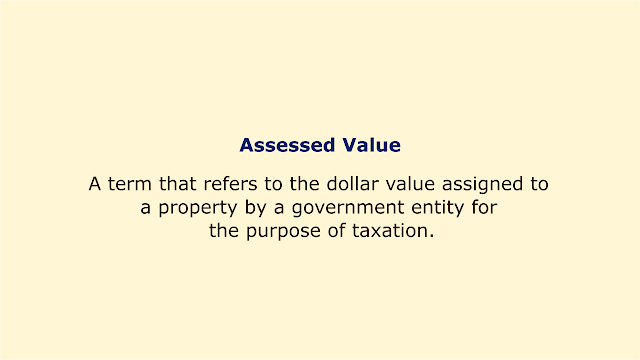 |
| Image: Moneybestpal.com |
The word "assessed value" refers to the monetary amount that a government body has put on a property for taxation purposes. It differs from the market value, which is the price at which the property may be sold on the open market.
The assessed value of a property is determined by a number of variables, including its location, its characteristics, its condition, and recent sales. It is determined by multiplying the property's fair market value by an assessment ratio, which is a percentage determined by each taxing authority.
Why is assessed value important? There are three main reasons:
How is an assessed value calculated? The process varies depending on the state and locality, but it generally involves the following steps:
The following table summarizes an example of how assessed value is calculated for a hypothetical property:
A property's assessed value may alter over time as a result of shifting market conditions, physical renovations or depreciation, or government reassessments. If a property owner feels that their assessed value is unfair or wrong, they may contest it or file an appeal. To back up their assertion, they can offer proof like recent sales figures or appraisal reports.
Why is assessed value important? There are three main reasons:
- Assessed value influences how much a property owner must pay in property taxes. Local governments rely heavily on property taxes for funding public services including infrastructure, health care, and education. The assessed value determines how much property taxes will cost.
- Assessed value has an impact on how much property insurance a property owner requires. Property insurance is a sort of coverage that guards the home against loss or damage brought on by fire, theft, vandalism, and other risks. The amount of property insurance needed is determined by the property's replacement cost, which is frequently based on the assessed value. The replacement cost and insurance premium increase in direct proportion to the evaluated value.
- Assessed value gives prospective buyers or sellers a ballpark figure for the value of the property. Despite the fact that the assessed value does not reflect the actual market value of the property, it might provide a general idea of its worth in comparison to nearby properties that are similar to it. Also, it might aid both buyers and sellers in settling on a reasonable property price.
How is an assessed value calculated? The process varies depending on the state and locality, but it generally involves the following steps:
- A government assessor physically examines the property and records data on its dimensions, age, state, layout, and features. In order to compare the property to other comparable homes in the neighborhood, the assessor may also use computerized data from real estate databases.
- Based on the data gathered, the assessor estimates the fair market value of the property. In an open and competitive market, the fair market value is an estimate of the price at which the property would sell.
- To arrive at the assessed value, the assessor multiplies the fair market value by an assessment ratio. A percentage that differs from one tax jurisdiction to another is the assessment ratio. For instance, the assessed value of a property would be $400,000 ($500,000 x 0.8) if the fair market value was $500,000 and the assessment ratio was 80%.
- Any applicable tax exemptions or discounts are subtracted by the assessor. Benefits that lessen the taxable value of a property for certain eligible groups, such as senior citizens, veterans, or homeowners, are tax exemptions or reductions. For instance, if a property is assessed at $400,000 and qualifies for a $50,000 homestead exemption, the taxable value is $350,000 ($400,000 - $50,000).
- To determine the amount of property taxes due, the assessor multiplies the taxable value by the tax rate. The tax rate is a fraction that changes depending on the tax jurisdiction. For instance, if a property has a $350,000 taxable value and a 1% tax rate, the property tax payment will be $3,500 ($350,000 x 0.01).
The following table summarizes an example of how assessed value is calculated for a hypothetical property:
| Image: Moneybestpal.com |
A property's assessed value may alter over time as a result of shifting market conditions, physical renovations or depreciation, or government reassessments. If a property owner feels that their assessed value is unfair or wrong, they may contest it or file an appeal. To back up their assertion, they can offer proof like recent sales figures or appraisal reports.
